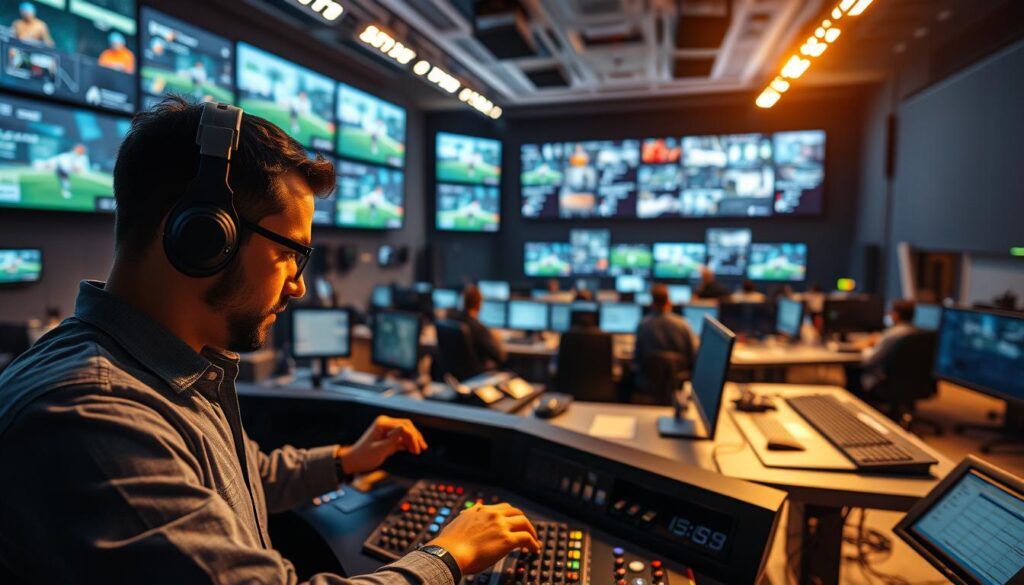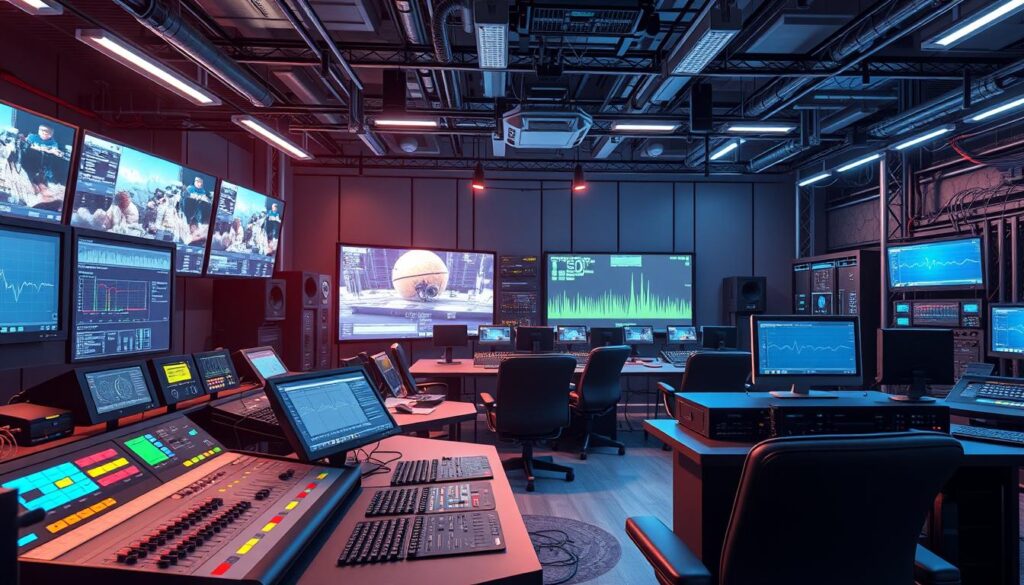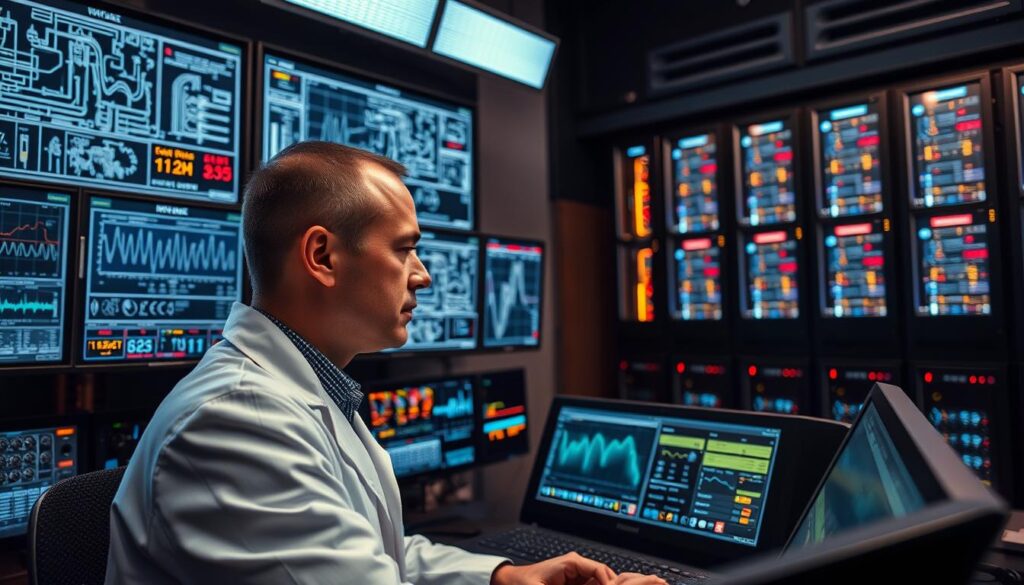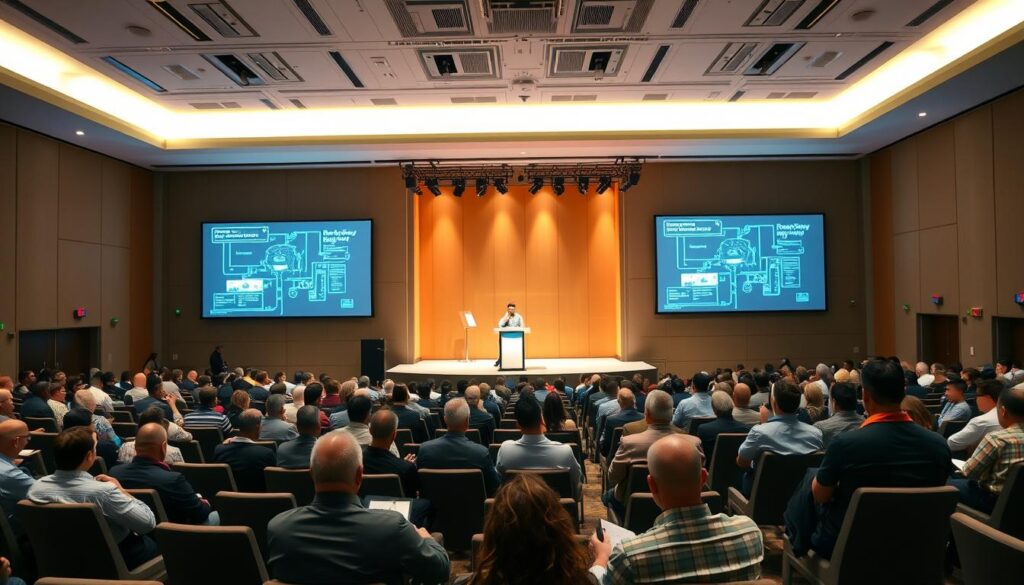How is the media industry adapting to the rapid evolution of technology to deliver high-quality content to global audiences? The answer lies in broadcast technology, a critical component that has revolutionized the way media is consumed.
The media landscape is undergoing a significant transformation, driven by advancements in broadcast infrastructure. This shift is enabling the transmission of high-quality content to audiences worldwide, making media more accessible than ever.
As technology continues to evolve, the field of broadcast engineering is at the forefront, powering the future of media. This involves not just the transmission of content, but ensuring it reaches the audience with the highest quality and reliability.
Key Takeaways
- The media industry is undergoing a significant transformation driven by advancements in technology.
- Broadcast technology is crucial for delivering high-quality content to global audiences.
- The evolution of broadcast infrastructure is key to this transformation.
- Broadcast engineering is vital for the future of media, focusing on quality and reliability.
- The industry’s adaptation to new technologies is enhancing media accessibility worldwide.
What is Broadcast Engineering?
At the heart of the broadcasting industry lies broadcast engineering, a field that encompasses the technical aspects of transmitting media content. As noted by industry experts, “Broadcast engineering is crucial for ensuring the quality and reliability of broadcasts.”
Definition of Broadcast Engineering
Broadcast engineering refers to the technical aspects of broadcasting, including the design, installation, and operation of equipment and systems used for transmitting audio and video content. This field is critical for delivering high-quality broadcasts to the public.
Key Components of Broadcast Engineering
The key components of broadcast engineering include transmitters, receivers, antennas, and broadcasting towers, as well as audio and video equipment. These components work together to ensure that broadcasts are transmitted efficiently and effectively.
Understanding these components is essential for broadcast engineers, as they are responsible for maintaining the integrity of the broadcast signal. As the broadcasting landscape continues to evolve, the importance of skilled broadcast engineers cannot be overstated.
The Role of Broadcast Engineers
Broadcast engineers are the backbone of the media industry, ensuring that broadcasts are transmitted smoothly and efficiently. Their work is crucial for the successful operation of television and radio broadcasts.

Responsibilities and Duties
The responsibilities of broadcast engineers are diverse and demanding. They are tasked with the maintenance and repair of broadcast equipment, ensuring that all technical aspects of broadcasting are functioning correctly. This includes:
- Performing routine maintenance on transmitters, antennas, and other broadcasting equipment.
- Troubleshooting technical issues during live broadcasts.
- Upgrading equipment to keep up with the latest technological advancements in broadcast engineering.
Broadcast engineers also work closely with other teams to plan and execute broadcasts. This collaboration is essential for ensuring that broadcasts are carried out seamlessly.
Required Skills and Qualifications
To succeed as a broadcast engineer, one must possess a strong technical background in broadcast engineering and maintenance. Key skills include:
- Proficiency in operating and maintaining broadcast equipment.
- Excellent problem-solving skills to troubleshoot issues quickly.
- The ability to work under pressure, particularly during live broadcasts.
As stated by a veteran broadcast engineer, “The key to success in this field is staying up-to-date with the latest technologies and being able to adapt quickly to new systems and equipment.”
“The broadcasting industry is constantly evolving, and broadcast engineers must be prepared to innovate and adapt to new challenges and technologies.”
In conclusion, broadcast engineers play a vital role in the media industry, requiring a unique blend of technical expertise, problem-solving skills, and the ability to work under pressure. As television broadcast and other forms of broadcasting continue to evolve, the importance of skilled broadcast engineers will only continue to grow.
Historical Evolution of Broadcast Engineering
The history of broadcast engineering is a story of continuous innovation, transforming the way we consume media. Over the years, broadcast engineering has undergone significant changes, driven by advances in technology and changing consumer demands.
From AM Radio to Digital Broadcasting
The journey of broadcast engineering began with AM radio, which laid the foundation for modern broadcasting. AM radio technology allowed for the transmission of audio signals over long distances, revolutionizing communication and entertainment.
As technology progressed, FM radio emerged, offering higher sound quality and less static interference. This transition marked a significant improvement in broadcast quality, enhancing the listener experience.
The advent of digital broadcasting further transformed the landscape, enabling the transmission of high-definition content and additional services. Digital broadcasting has improved broadcast quality, increased efficiency, and opened up new opportunities for broadcasters.
The Impact of Technology on Broadcasting
Technological advancements have been the driving force behind the evolution of broadcast engineering. The development of new technologies has enabled broadcasters to improve transmission quality, expand their reach, and offer new services.
The introduction of satellite broadcasting allowed for global coverage, connecting audiences worldwide. This technology has been instrumental in disseminating content across borders, fostering global communication and cultural exchange.
More recently, the rise of online streaming services has changed the way people consume media, offering on-demand access to a vast array of content. This shift has forced traditional broadcasters to adapt, incorporating digital technologies into their operations.
The impact of technology on broadcasting is evident in the improved quality, accessibility, and diversity of content available today. As technology continues to evolve, it is likely to further transform the broadcasting industry, enabling new services and enhancing the viewer experience.
Types of Broadcast Media
Broadcast media has evolved significantly, offering a range of options including television, radio, and online streaming services. This diversity allows audiences to choose how they consume media, whether it’s through traditional means or modern platforms.
Television Broadcasting
Television broadcasting remains a dominant force in the media landscape. It provides a visual platform for news, entertainment, and educational content. With advancements in technology, television broadcasting has transitioned from analog to digital signals, improving quality and accessibility.
Key Features of Television Broadcasting:
- High-definition video quality
- Wide range of channels catering to different interests
- Live event broadcasting capabilities
Radio Broadcasting
Radio broadcasting continues to be a popular medium for music, news, and entertainment. Its accessibility and portability make it a favorite among audiences. Radio broadcasting has also adapted to digital technologies, offering better sound quality and additional services like streaming.
Advantages of Radio Broadcasting:
- Wide coverage area
- Cost-effective production
- Ability to target specific demographics
Online Streaming Services
Online streaming services have revolutionized the way people consume media. They offer on-demand content, allowing viewers to watch or listen at their convenience. These services have become increasingly popular, with many providers offering a range of content from original series to live sports.
Characteristics of Online Streaming Services:
- On-demand access to content
- Personalized recommendations based on viewing history
- Multi-device support for viewing on various platforms
Comparing these broadcast media types, we can see their unique strengths and how they cater to different audience preferences.
| Media Type | Key Features | Audience Benefits |
|---|---|---|
| Television Broadcasting | High-definition video, live events | Immersive viewing experience, real-time event coverage |
| Radio Broadcasting | Portable, cost-effective, targeted demographics | Accessible on-the-go, affordable entertainment, niche content |
| Online Streaming Services | On-demand content, personalized recommendations | Flexibility in viewing times, tailored content suggestions |

In conclusion, the types of broadcast media available today offer a wide range of choices for consumers. Understanding the strengths of each platform is crucial for content creators and broadcasters aiming to reach their target audiences effectively.
Essential Equipment in Broadcast Engineering
Essential equipment in broadcast engineering plays a critical role in delivering high-quality broadcasts to viewers and listeners. The reliability and quality of this equipment directly impact the overall broadcast experience.
Transmitters and Receivers
Transmitters are crucial for broadcasting signals over various frequencies, while receivers decode these signals for end-users. Modern transmitters are designed to be highly efficient, with some models offering redundancy to ensure continuous operation.
- Transmitters convert content into a signal that can be broadcast.
- Receivers capture and decode the broadcast signal.
- Advanced transmitters offer features like automatic backup systems.
Antennas and Broadcasting Towers
Antennas are vital for signal propagation, determining the coverage area of a broadcast. Broadcasting towers, often equipped with multiple antennas, are designed to maximize signal strength and coverage.
- Antennas are designed to optimize signal transmission.
- Broadcasting towers can be quite tall to ensure wide coverage.
- The height and location of towers are critical for signal propagation.
Audio and Video Equipment
High-quality audio and video equipment is necessary for capturing and processing content. This includes cameras, mixers, and switchers that enable broadcast engineers to produce professional-grade content.
- Cameras capture high-definition video.
- Mixers and switchers allow for seamless transitions between different sources.
- Professional audio equipment ensures clear and crisp sound.
By understanding and utilizing the right equipment, broadcast engineers can ensure a high-quality viewing and listening experience for their audience.
The Process of Broadcast Transmission
The process of broadcast transmission is multifaceted, requiring precise techniques to ensure signal integrity and quality. At its core, broadcast transmission involves converting content into a signal that can be received by audiences through various devices.
To achieve high-quality transmission, two critical steps are involved: signal encoding and compression, and the use of appropriate transmission methods and technologies. Let’s delve into these aspects to understand their significance in broadcast engineering.
Signal Encoding and Compression
Signal encoding and compression are essential for preparing content for transmission. Encoding involves converting the content into a digital format that can be transmitted efficiently. Compression reduces the size of the digital content, allowing it to be transmitted more quickly without significant loss of quality.
- Encoding formats like H.264 for video and AAC for audio are widely used in broadcast transmission.
- Compression algorithms help reduce the bitrate, making it possible to transmit high-definition content over limited bandwidth.
The table below summarizes some common encoding and compression techniques used in broadcast transmission:
| Technique | Description | Application |
|---|---|---|
| H.264 Encoding | Video encoding standard | HD Video Transmission |
| AAC Compression | Audio compression format | Digital Radio Broadcasting |
| MPEG-2 Compression | Video and audio compression | Standard Definition TV |
Transmission Methods and Technologies
The method of transmission is just as crucial as the preparation of the signal. Various technologies are employed to deliver the broadcast signal to the audience.
Transmission Methods include:
- Terrestrial broadcasting, which uses ground-based infrastructure like towers.
- Satellite broadcasting, which relies on satellites orbiting the Earth.
- Cable broadcasting, which transmits signals through physical cables.
- Internet Protocol Television (IPTV), which delivers content over the internet.
Each method has its advantages and is suited to different types of content and audience needs.

Understanding the process of broadcast transmission is vital for ensuring that content is delivered reliably and with the best possible quality. By leveraging the right encoding, compression, and transmission technologies, broadcast engineers can meet the demands of modern media consumption.
Challenges in Broadcast Engineering
Signal quality and regulatory compliance are among the key challenges in broadcast engineering. As the demand for high-quality broadcasts continues to grow, engineers must navigate a complex landscape of technical and regulatory issues.
Signal Interference and Quality Issues
Signal interference is a significant challenge in broadcast engineering, affecting the quality of the broadcast signal. Sources of interference can include other broadcasts, physical barriers, and equipment malfunctions. For instance, a broadcast tower located near a major highway may experience interference from vehicles equipped with high-powered radios.
Multipath interference, where signals arrive at the receiver via multiple paths, can also degrade signal quality. To mitigate this, broadcast engineers employ techniques such as diversity reception and signal equalization. As noted by a leading broadcast engineer, “Signal quality is paramount; a single disruption can affect thousands of viewers.”
“The biggest challenge we face is ensuring that our signal remains clear and uninterrupted. It’s a constant battle against interference and equipment failure.” – John Smith, Broadcast Engineer
Regulatory Compliance and Licensing
Regulatory compliance is another critical challenge in broadcast engineering. Broadcasters must adhere to strict regulations regarding signal strength, frequency allocation, and content standards. Licensing requirements vary by country and region, adding complexity to the compliance process.
For example, in the United States, the Federal Communications Commission (FCC) oversees broadcast licensing and regulation. Broadcast engineers must ensure that their equipment and operations meet FCC standards to avoid fines and penalties. As the FCC notes, “Compliance is key to maintaining a fair and orderly broadcast spectrum.”
To address these challenges, broadcast engineers must stay up-to-date with the latest technologies and regulatory requirements. This includes investing in advanced equipment and training to ensure compliance and high-quality broadcasts.
The Future of Broadcast Engineering
The broadcast engineering landscape is on the cusp of a revolution, driven by emerging technologies. As the media industry continues to evolve, the demand for high-quality, reliable broadcast solutions is increasing. This shift is being fueled by advancements in broadcast technology, including IP-based broadcasting and cloud-based services.
Emerging Technologies in Broadcasting
Several emerging technologies are transforming the broadcast engineering sector. IP-based broadcasting allows for more flexible and scalable content delivery, while cloud-based services enable greater collaboration and efficiency. Additionally, the use of artificial intelligence (AI) and machine learning (ML) is becoming more prevalent, enabling broadcasters to automate tasks, improve content quality, and enhance viewer experiences.

The adoption of these technologies is not only improving the technical aspects of broadcasting but also opening up new opportunities for content creators and consumers alike. For instance, the integration of AI in broadcast engineering is allowing for more personalized content recommendations and automated content analysis.
The Impact of AI and Automation
The impact of AI and automation on broadcast engineering cannot be overstated. These technologies are streamlining workflows, reducing costs, and enabling broadcasters to focus on high-value tasks such as content creation and strategy. A key area where AI is making a significant impact is in the automation of broadcast workflows, such as signal processing and transmission.
| Technology | Application | Benefit |
|---|---|---|
| IP-based broadcasting | Content delivery | Flexibility and scalability |
| Cloud-based services | Collaboration and storage | Enhanced efficiency and reduced costs |
| AI and automation | Workflow automation and content analysis | Improved productivity and quality |
As broadcast engineering continues to evolve, it’s clear that emerging technologies will play a crucial role in shaping the industry’s future. By embracing these innovations, broadcasters can stay ahead of the curve and deliver high-quality content to audiences worldwide.
Broadcast Engineering in Live Events
The role of broadcast engineering in live events cannot be overstated, as it enables the seamless delivery of content to global audiences. Live events, such as sports, concerts, and news coverage, rely heavily on broadcast engineering to provide viewers with an immersive experience.
Techniques for Capturing Live Footage
Capturing high-quality live footage involves the use of advanced equipment and techniques. Broadcast engineers utilize a range of cameras, including handheld, Steadicam, and robotic cameras, to capture dynamic footage. The use of switchers allows for smooth transitions between different camera angles, enhancing the viewer’s experience.
Key Equipment for Live Footage:
- High-definition cameras
- Switchers for camera angle transitions
- Audio equipment for clear sound
- Transmission equipment for reliable broadcast
Challenges of Broadcasting Live Events
Broadcasting live events presents several challenges, including ensuring reliable transmission, managing complex logistics, and meeting tight deadlines. Broadcast engineers must be prepared to adapt to changing circumstances and overcome technical issues promptly.
The following table highlights some of the common challenges and their potential solutions:
| Challenge | Solution |
|---|---|
| Signal Interference | Use of redundant transmission paths and signal amplification |
| Logistical Complexity | Detailed planning and coordination among teams |
| Tight Deadlines | Pre-event testing and contingency planning |
By understanding these challenges and employing effective techniques, broadcast engineers can ensure the successful broadcast of live events.
The Importance of Broadcast Standards
The importance of broadcast standards cannot be overstated, as they directly impact the viewer experience and industry innovation. Broadcast standards are essential for ensuring compatibility and quality across different platforms and devices.

Understanding Broadcast Formats
Broadcast formats such as HD and 4K are critical for delivering high-quality content. Understanding these formats is vital for broadcast engineers to ensure that content is transmitted in the best possible quality.
Some key broadcast formats include:
- HD (High Definition): Offers superior picture quality compared to standard definition.
- 4K (Ultra High Definition): Provides an even higher resolution than HD, resulting in a more detailed viewing experience.
- Dolby Atmos: An advanced audio format that offers immersive sound.
The Role of Standards Organizations
Standards organizations, such as the Society of Motion Picture and Television Engineers (SMPTE), play a crucial role in developing and maintaining broadcast standards. These organizations work to ensure interoperability and best practices within the industry.
The key responsibilities of standards organizations include:
- Developing technical standards for broadcasting.
- Maintaining existing standards to keep them relevant with technological advancements.
- Promoting industry-wide adoption of standards.
By adhering to broadcast standards and understanding the various broadcast formats, the industry can continue to innovate and provide high-quality content to viewers worldwide.
Broadcast Engineering and Audience Engagement
The intersection of broadcast engineering and audience engagement represents a new frontier in media, where technology meets viewer interaction. As broadcast engineering continues to evolve, it plays a crucial role in enhancing the viewer experience and fostering a more engaged audience.
Techniques for Enhancing Viewer Experience
Broadcast engineers employ several techniques to enhance the viewer experience, including the use of interactive services and personalized content. Interactive services allow viewers to participate in broadcasts in real-time, creating a more immersive experience.
Personalized content, on the other hand, is tailored to individual preferences, making the viewing experience more relevant and engaging. This is achieved through data analytics and content delivery networks that can adapt to viewer behavior.
The Role of Social Media in Broadcasting
Social media has become an integral part of broadcasting, enabling real-time interaction and feedback between broadcasters and their audiences. It allows for the creation of communities around content, fostering a more engaged and loyal viewer base.
Broadcasters can leverage social media platforms to promote their content, share behind-the-scenes insights, and engage in direct conversations with viewers. This not only enhances the viewer experience but also provides valuable feedback for broadcasters.
| Technique | Description | Impact on Viewer Experience |
|---|---|---|
| Interactive Services | Allows real-time participation in broadcasts | Enhances engagement and immersion |
| Personalized Content | Tailors content to individual preferences | Increases relevance and viewer satisfaction |
| Social Media Integration | Fosters real-time interaction and community building | Boosts engagement and loyalty |
Sustainable Practices in Broadcast Engineering
The broadcast engineering community is embracing sustainable practices to minimize its ecological footprint. As concern for the environment grows, the industry is focusing on reducing its impact through various initiatives.
Energy Efficiency in Broadcasting Infrastructure
One key area of focus is energy efficiency in broadcasting infrastructure. Broadcast engineers are exploring ways to minimize power consumption by using energy-efficient equipment and optimizing transmission systems. For instance, newer transmitter technologies can significantly reduce energy usage while maintaining or even improving signal quality.
Energy-efficient practices not only benefit the environment but also help reduce operational costs for broadcasters. By investing in energy-saving technologies, broadcasters can lower their utility bills and allocate resources more effectively.

Environmental Impact Considerations
Another crucial aspect is assessing the environmental impact of broadcast operations. This includes evaluating the ecological effects of broadcasting infrastructure, such as towers and transmission facilities. Broadcast engineers are working to reduce waste and implement environmentally friendly technologies throughout their operations.
By adopting sustainable practices, the broadcast industry can enhance its reputation and contribute to a more environmentally conscious future. This involves not just reducing energy consumption but also considering the overall lifecycle impact of broadcasting equipment and infrastructure.
As the industry continues to evolve, the adoption of sustainable practices will play a critical role in shaping its future. By prioritizing energy efficiency and minimizing environmental impact, broadcast engineers can help create a more sustainable broadcasting ecosystem.
Training and Certifications for Broadcast Engineers
As broadcast technology advances, the need for skilled engineers with up-to-date training and certifications becomes increasingly important. The field demands a workforce that is not only proficient in the latest broadcasting technologies but also committed to ongoing education and professional development.
Educational Pathways in Broadcast Engineering
Aspiring broadcast engineers can pursue various educational pathways to gain the necessary skills and knowledge. These include:
- Degree Programs: Many colleges and universities offer degree programs in broadcast engineering or related fields such as electrical engineering, telecommunications, or media production.
- Vocational Training: Specialized vocational training programs provide hands-on experience with broadcast equipment and technologies.
- Online Courses: Online platforms offer flexible learning opportunities, allowing engineers to update their skills at their own pace.
These educational pathways provide a foundation for a career in broadcast engineering, equipping individuals with the technical knowledge and practical skills required in the industry.
Industry Certifications and Their Importance
Industry certifications play a crucial role in validating the expertise of broadcast engineers. Certifications such as those offered by the Society of Broadcast Engineers (SBE) demonstrate a commitment to staying current with industry standards and technologies.
The benefits of industry certifications include:
- Enhanced job prospects due to demonstrated expertise.
- Recognition within the industry for adhering to best practices.
- Opportunities for career advancement and higher salary potential.
By pursuing relevant training and certifications, broadcast engineers can ensure they remain competitive in a rapidly evolving industry.
Case Studies in Broadcast Engineering
Examining case studies in broadcast engineering reveals the challenges faced by professionals and the innovative solutions they’ve implemented to overcome them. These real-world examples provide valuable insights into the complexities of broadcast engineering and the creative approaches used to address them.
Successful Broadcast Engineering Projects
Several broadcast engineering projects have made significant impacts on the industry. For instance, the transition from traditional analog broadcasting to digital broadcasting has been a monumental task, requiring substantial infrastructure changes and technological upgrades. This shift has enabled higher quality broadcasts, increased efficiency, and better use of bandwidth.
Some key aspects of successful broadcast engineering projects include:
- Innovative Technology Adoption: Leveraging the latest technologies to improve broadcast quality and efficiency.
- Strategic Planning: Careful planning to ensure seamless transitions and minimal downtime.
- Collaboration and Partnerships: Working with various stakeholders, including technology providers, regulatory bodies, and other industry players.

Innovations in Broadcast Technology
The broadcast engineering field is continually evolving, driven by technological innovations that enhance the viewing and listening experience. Some of the significant advancements include:
- IP-Based Broadcasting: The shift towards IP-based broadcasting allows for more flexible and scalable broadcasting solutions.
- Virtualization and Cloud Technologies: These technologies enable more efficient use of resources, improved scalability, and reduced costs.
- Advanced Compression Techniques: New compression algorithms enable higher quality video and audio to be transmitted over limited bandwidth.
These innovations are not only improving the technical aspects of broadcasting but also opening up new possibilities for content creation and distribution. As the media landscape continues to evolve, the role of broadcast engineering in shaping the future of media remains crucial.
Broadcast Engineering Careers
Broadcast engineering is a dynamic field that encompasses a broad spectrum of career opportunities, driven by technological innovation and changing viewer habits. As the media landscape continues to evolve, the demand for skilled broadcast engineers is on the rise, offering a range of career paths for individuals with the right skills and qualifications.
Job Opportunities and Career Paths
Broadcast engineering careers span various roles, including:
- Technical engineers responsible for the maintenance and operation of broadcast equipment
- Production engineers who oversee the technical aspects of live and pre-recorded broadcasts
- Transmission engineers who ensure the quality and reliability of signal transmission
- Leadership roles, such as technical directors and broadcast managers, who oversee teams and make strategic decisions
These roles require a combination of technical knowledge, problem-solving skills, and the ability to work under pressure. Career advancement opportunities are available for those who gain experience and expand their skill set.
Salary Expectations in the Industry
Salary expectations for broadcast engineers vary based on factors such as location, experience, and specific job roles. According to industry reports, the median salary for broadcast engineers in the United States is competitive, with experienced professionals earning higher wages.
Some key factors influencing salary include:
- Level of experience: More experienced engineers can command higher salaries.
- Location: Salaries can vary significantly depending on the location, with major broadcasting hubs often offering higher pay.
- Specific job role: Different roles within broadcast engineering have different salary ranges.
Overall, broadcast engineering careers offer a rewarding combination of technical challenge, creative opportunity, and financial compensation, making them an attractive choice for individuals passionate about media and technology.
Networking and Professional Development
Networking and professional development are vital components of a successful career in broadcast engineering. As the industry continues to evolve with new technologies and methodologies, staying connected and informed is crucial for professionals in this field.
Industry Conferences and Events
Industry conferences and events provide broadcast engineers with opportunities to learn about the latest advancements, share knowledge, and network with peers. These events range from large international conferences to smaller, more specialized seminars.
Benefits of Attending Industry Events:
- Learning about new technologies and trends
- Networking opportunities with industry professionals
- Access to workshops and training sessions
- Insight into industry best practices
Some notable events include the annual Broadcast Engineering Conference and the SBE Symposium, which attract professionals from around the world.

Joining Professional Organizations
Joining professional organizations is another effective way for broadcast engineers to enhance their careers. Organizations such as the Society of Broadcast Engineers (SBE) offer a range of benefits, including access to training resources, certification programs, and networking opportunities.
| Organization | Benefits | Certifications Offered |
|---|---|---|
| Society of Broadcast Engineers (SBE) | Training resources, networking, industry events | CPB, CBE, CBT |
| National Association of Broadcasters (NAB) | Advocacy, industry events, educational resources | NAB Certification |
By engaging with these organizations, broadcast engineers can stay updated on industry developments and enhance their professional credentials.
Conclusion: Embracing the Future of Broadcast Engineering
The media industry’s continuous evolution underscores the significance of broadcast engineering in shaping its future. As technology advances, the role of broadcast engineers becomes increasingly vital in delivering high-quality content to audiences worldwide.
Innovation at the Forefront
Innovation remains a driving force in broadcast engineering, enabling the industry to stay ahead of the curve. Emerging technologies, such as AI and automation, are being integrated into broadcasting, enhancing efficiency and viewer experience. The ongoing importance of innovation in broadcast engineering cannot be overstated, as it paves the way for new services and improved content delivery.
Nurturing the Next Generation
Encouraging the next generation of engineers is crucial for the future of broadcast engineering. By providing training and certifications, the industry can ensure that aspiring engineers are equipped with the necessary skills to succeed. As the industry continues to evolve, it is essential to inspire and support new talent, driving innovation and growth in broadcast engineering.
